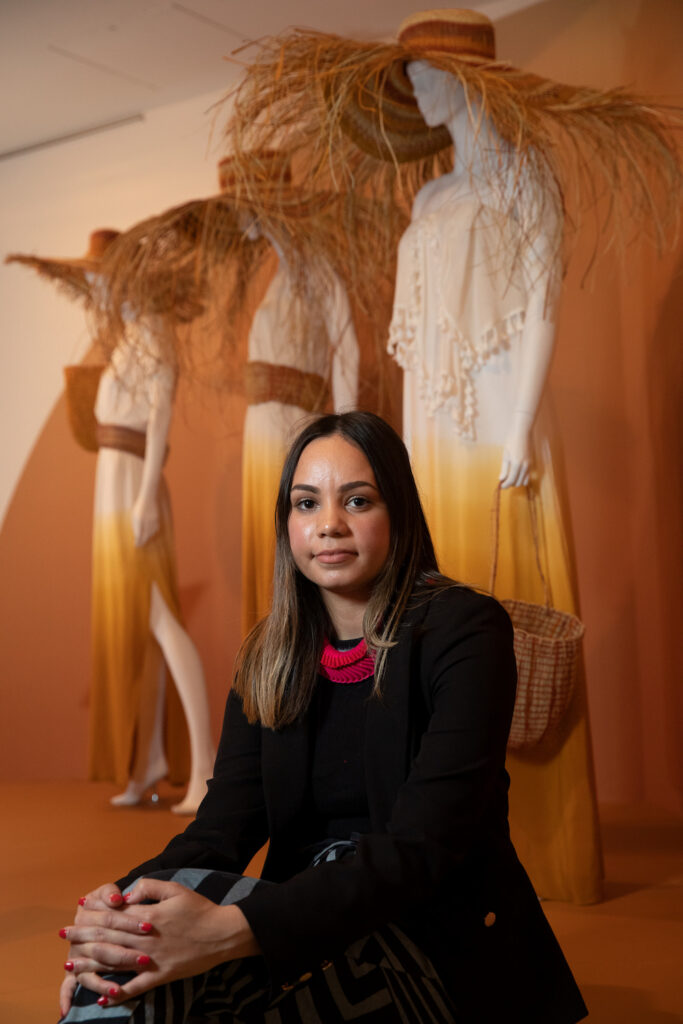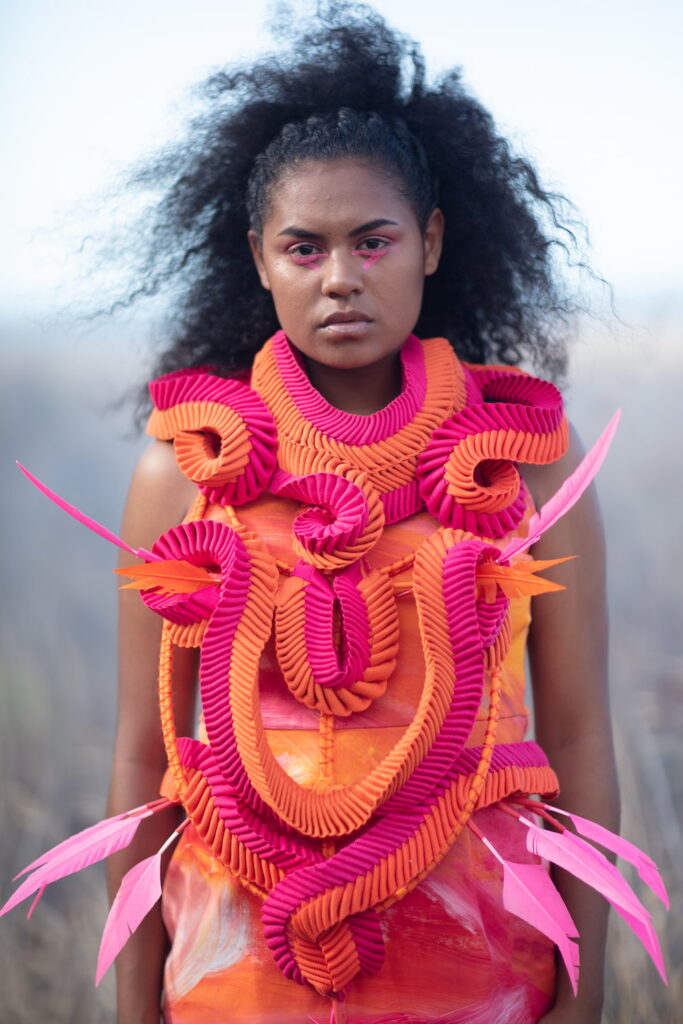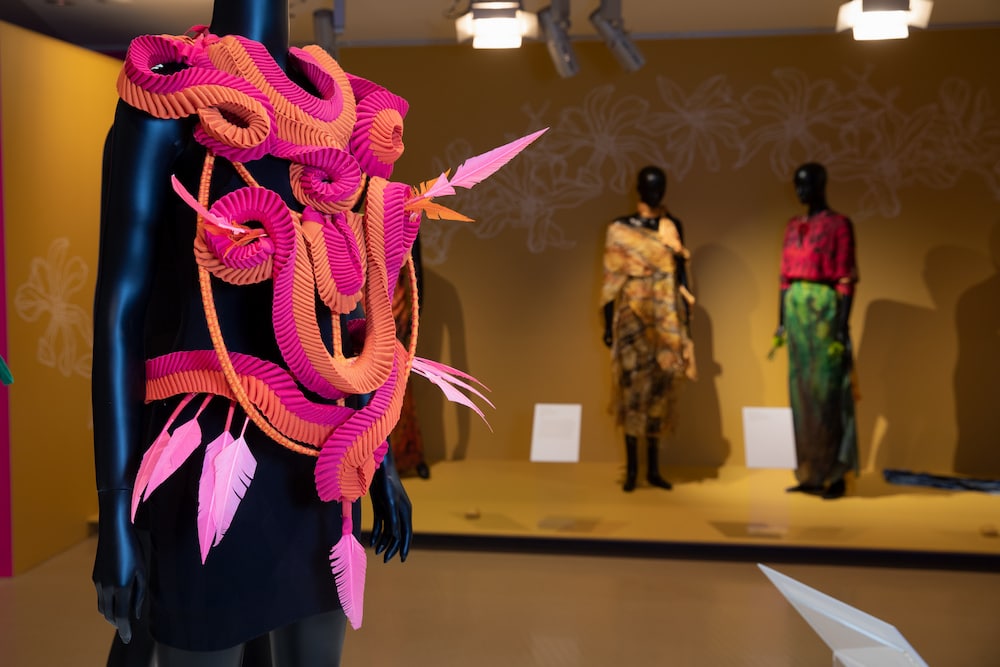Australia’s first major survey of contemporary Indigenous textiles and fashion officially opened at the National Museum of Australia today, marking a significant moment in Australia’s history.
On display in Canberra from 20 February to 8 August as part of a national tour, Bendigo Art Galley’s Piinpi: Contemporary Indigenous Fashion brings together around 60 works of Indigenous artists and designers from the inner city to remote desert art centres, celebrating Australia’s leading First Nations creatives.
National Museum of Australia Director Dr Mathew Trinca said the Museum is delighted to bring this extraordinary exhibition to Canberra.
“It will provide a joyful start to 2021 as one of the key celebrations during the Museum’s 20th anniversary year and an exquisite showcase of exciting new work from rising stars in Indigenous fashion design.
“We live on a land with an enormously long human history and in these wonderful works what we are touching is a distillation, contemporary expression of stories that reach back many thousands of years.”

Curated by Bendigo Art Galley’s First Nations curator, Kaantju woman, Shonae Hobson, the exhibition comes as part of a long-standing collaboration between the Alastair Swayn Foundation and the National Museum, through the Museum’s Swayn Fellowship in Australian Design.
Ms Hobson said the intention behind the exhibition is to “give audiences an opportunity to feel as if they’re being immersed onto Country”.
“For me, there was never any First Nations representation in fashion … I thought this is a really incredible opportunity to bring Indigenous fashion into the gallery and museum context,” she said.
Ms Hobson said ‘Piinpi’ is an expression that First Nations people from the East Cape York Peninsula use to describe seasonal changes in the landscape across time and space.
“One of the things I found when I was reaching and talking to the designers and artists is that the practice and the fashion is really based on Country and the connection to their culture,” she said.
“For many of the artists and designers in this exhibition, topographical features of the land, including river systems, waterways and native flora and fauna are primary sources of inspiration for their designs … Each work is handcrafted using ancient techniques and knowledge systems that convey a rich and vibrant culture that is both resilient and innovative.”
Some of the highlights of the exhibitions include four new pieces by Gunnai, Wiradjuri, Gunditjmara and Yorta Yorta woman, Lyn-Al Young, that capture the subtle transformations of Young’s Country over time, and several highly sculpted pieces by Grace Lillian Lee, a descendant of the Meriam Mir people of the Eastern islands of the Torres Strait.
Other creators and brands featured in the exhibition include Lisa Waup x Verner, Hopevale Arts and Culture Centre, MAARA Collective, the Yarrenyty Arltere Artists, AARLI Fashion and LORE.
Leila Naja Hibri, CEO of the Australian Fashion Council (AFC) said that seeing Piinpi for the first timegave her goosebumps.
“This is absolutely beautiful, not just from a fashion perspective, just a creative, artistic perspective and of course the Indigenous heritage perspective,” she said.
“We need to encourage and support the Indigenous fashion industry. I say that as CEO of the AFC, knowing that our industry hasn’t yet done enough.”
As the first major exhibition of contemporary Indigenous Australian fashion in Australia, Piinpi sheds light on a growing industry which is set to become Australia’s major fashion movement.
According to the Federal Minister for Industry, Science and Technology, Karen Andrews, Piinpi “showcases Indigenous fashion as clearly an emerging sector in the fashion industry but it also raises awareness of the history of Indigenous Australians”.

Photo: Wade Lewis
“The fashion industry supports about 200,000 workers across Australia … I don’t think many Australians understand the value the fashion industry provides to Australia,” Ms Andrews said.
“This exhibition showcases a very unique part of the fashion industry … It does have opportunity to grow. Australian Indigenous fashion is unique in the world and when you look around this exhibition, it’s outstanding … It really is high fashion.
“I would expect that there would be significant overseas markets for Australian Indigenous fashion so it’s now an opportunity for the government to work with the sector to see what support they need to be able to grow. Showcasing their work is a very, very good start,” the Minister said.
Ms Hobson said that fashion is a viable source of income for a growing number of Indigenous artists working in remote communities and the exhibition celebrates the key role fashion plays in shaping Indigenous story telling today and into the future.
“Piinpi features a collection of pioneer designers, artists and makers who are really carving and shaping the future of fashion and design in Australia as well as leading important conversations around ethical and sustainable practices,” she said.
“Indigenous fashion is not a trend but an important movement that is pushing Indigenous voices and artistic expression to the centre of the global fashion agenda.”



